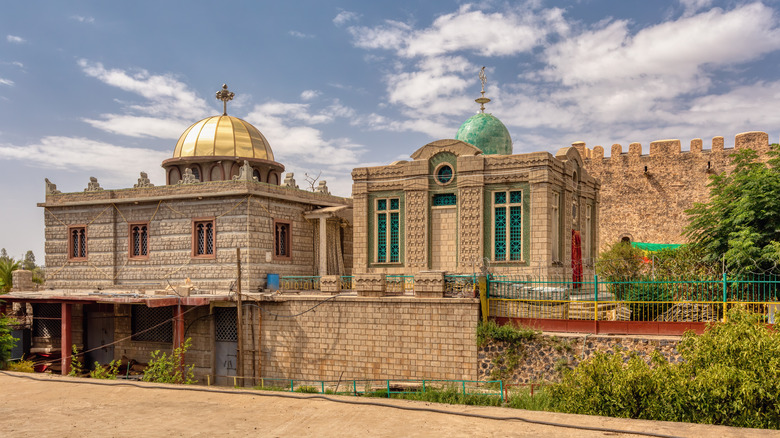Did The Ark Of The Covenant Really Exist?
The Bible is full of mysteries that have fascinated historians and believers for thousands of years. Perhaps the most famous of those is Noah's Ark, which still generates so much interest that search parties have been organized as recently as 2010. Another legendary artifact that has sparked the imagination of many is the Ark of the Covenant. The story goes that it was built about 3,000 years ago to store and preserve the Ten Commandments tablets and is made of gold and acacia wood. According to the Book of Exodus, God even gave very precise instructions regarding the size of the case — approximately 3.75x2.25x2.25 feet (via Live Science).
The Ark stayed with Moses' descendants until it was captured by the Philistines near the end of the Bronze Age — or so the story goes. According to World History, the Philistines then suffered plenty of misfortune, which included being covered in tumors and boils — which could have been an outbreak of the plague — and losing their crops. The Philistines soon had enough and sent it back to the Israelites. Eventually, the Ark is said to have found its home inside the massive Solomon's Temple (also known as the First Temple), built in the year 957 B.C.
But archaeologists aren't sure the temple ever existed. After all, a temple so large should have left some archaeological evidence of its existence behind, but nothing has ever been found (per Discover Magazine).
The Ark's whereabouts soon became unknown
The Ark of the Covenant "goes missing" from the record after the Babylonian Empire supposedly burns down the temple in 586 B.C. There are theories about what happened to the Ark itself. Some say it was destroyed in the fire, while others say it survived the fire and is hidden in subterranean passages located under the Dome of the Rock Islamic shrine, which cannot be excavated (via National Geographic).
The third theory is that the Ark ended up in Ethiopia in the 10th century B.C. and is being held inside the St. Mary of Zion cathedral in the tiny town of Aksum. According to reports via Smithsonian Magazine, nobody is allowed to enter the small room where the Ark is kept, and the monks who guard it aren't allowed to ever leave the chapel.
The Ethiopian church has plenty of explanations for its alleged connection to the Ark, including how one of its royals, Queen of Sheba, traveled to Jerusalem, where she had a child with King Solomon. Another story says Mary and Jesus spent time in Ethiopia during their exile from Israel. There are no records of any of these claims — including the legendary Ark making it into Africa — and all attempts to see the mysterious artifact have been turned down (per Smithsonian Magazine).
If you ever watched "Indiana Jones and the Raiders of the Lost Arkaiders of the Lost Ark," you'll know the Ark is believed to possess great supernatural powers — but you might not know the movie was inspired by a real expedition to find it.
The search for the Ark has never stopped
In 1909, British aristocrat Captain Montagu Brownlow Parker embarked on what would become the biggest and most bizarre archeological search for the Ark of the Covenant ever attempted. According to Smithsonian Magazine, Parker's team consisted of a psychic, a poet, a cricket player, and a somewhat experienced steamboat pilot. No historians, no archeologists.
Parker arrived in Jerusalem (which was at the time under the rule of the Ottoman Empire) hoping to find the Ark as well as a number of other objects from the time of King Solomon. After securing an excavation permit, Parker intended to dig on a nearby hill to find a secret tunnel that he'd been told ran under the Dome of the Rock and would lead him to the Ark. And while the hired local workers found ancient passages here and there over a period of almost two years, none truly led anywhere or held any treasures. In a last desperate attempt, Parker illegally entered the cave right under the holy shrine and started to dig. He was caught by locals and had to flee the country, but not before he almost caused a holy war.
Today, the Ark of the Covenant continues to capture the imagination of people around the world — whether real or not. After all, "Even if there is an ancient, Ark-like object in Ethiopia, he asks, how do you determine it's the one from the Bible?" archaeologist Fred Hiebert asked National Geographic.


